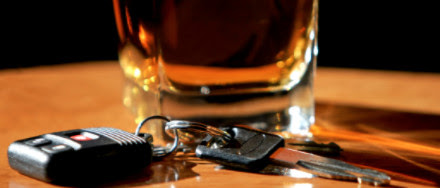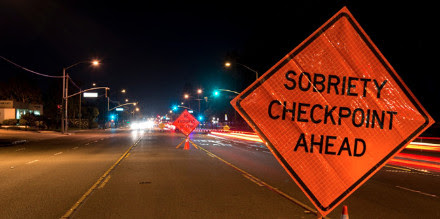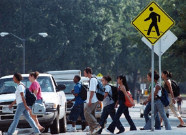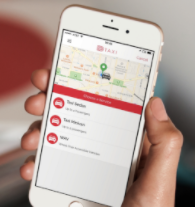IN THIS ISSUE
Distractions taking a deadly road toll
Drunk, drugged, and sleepy: impaired motorists pose huge vehicular risks
We curbed the carnage before, and we can commit to doing it again
Pedestrians and bikers, beware
Taxi, bus, train drivers can be distracted, too
BY THE NUMBERS
40,000
Estimated U.S. road fatalities in 2016, the deadliest year since 2007
14%
Increase in U.S. road deaths 2016 over 2014
$432 billion
Cost to society for medical services, lost work and wages from 4.6 million U.S. roadway injuries in 2016
660,000
Number of U.S. drivers, who, at any given moment during the day time, are also using cell phones or other electronic devices
5 seconds
Average estimated time a driver’s eyes are off the road to text –– which at 55 mph carries a car well over a football field length down the road
Our vehicles are killing us – and we can do a lot to stop it

Dear Reader,
They’re our pride and joy, and we rely on them to get us everywhere we need to go. We’re logging ever more miles with them. But there’s a downside to Americans’ vehicular love affair: Our cars—especially the way we drive them— are killing us as never before.
Road deaths are up 14 percent in 2016 from 2014. That’s the most dramatic increase in a half-century. More than 40,000 Americans died in motor vehicle crashes last year, the deadliest since 2007. The road toll was double the deaths due to murders in America and about equal to the number of lives lost to breast cancer.
The increasing carnage adds up to a public health crisis.
We’re all to blame for it. But, as a New York Times columnist has argued, we also can fix this woe. Fatalities, experts say, are 94 percent attributable to “human factors,” that is to us and what we do. We’re driving too much while distracted, drunk, drugged, and drowsy. Don’t think it doesn’t apply to you. The deadly driving sins of distraction and impairment need your rapt attention to save lives, your own included, and to prevent costly harms.
Distractions taking a deadly road toll

A quick online search, sadly, pulls up a slew of evidence:
- Carlee R. Boling, 17, of Little Falls, Minn., will live the rest of her life as a felon, convicted of criminal vehicular homicide for killing Charles P. Maurer, 54, and his daughter, Cassy, 10. Ignoring friends’ repeated pleas to stop texting and looking at Facebook on her cell phone, Boling plowed through a red light, causing a fatal collision.
- Laura Maurer, 40, an Iowa housewife, struggles daily with the guilt of killing Marvin Beck, 75, a farmer, father of four, and grandfather to 11. He was sitting atop a small tractor pulling a tiller. She was texting on her mobile phone. She didn’t see Beck before she slammed into him on the side of the road. He died in her arms. She was cited, and has been jailed for her crime. She says she can’t rid herself of sleeplessness and guilt.
- Authorities are still sorting out the involuntary manslaughter charges filed against John Miller IV, 45, of Leesburg, Va. He drove a Jeep Cherokee that struck and killed Tristan Schulz as his mother, Mindy, rolled the five-month-old boy through a crosswalk in a stroller. Search warrants and sworn statements show that a driver behind Miller saw him with a cell phone in hand just before the crash, and a voice mail was deleted from his accounts at the time of the fatal incident.
A rising safety bane
These and myriad other road deaths and injuries are part of what authorities say is the newest, and rising, safety bane: Distracted driving. It’s fueled in part by improving economic conditions that have increased Americans’ miles on the road, time in their vehicles, and access to and use of mobile technologies. Gadgets are burgeoning in our cars and trucks, and we’re all obsessively multi-tasking, especially with ubiquitous cell phones.
As I note on our firm’s website— where you’ll find extensive resources about auto, truck, and motorcycle collisions—vehicle wrecks are scary, especially when they result in injuries. But the real worry about harm that should help us focus on a critical task before us seems to have evaporated as, experts say, distracted driving has become epidemic. It now is way too common to see ourselves and others:
- Talking on the cellphone
- Texting
- Using a GPS navigation system
- Putting on makeup
- Disciplining children in the backseat
- Changing the blaring radio station
- Rubbernecking
- Reading a billboard or store sign
- Surfing the Internet
- Reading a book or a map
- Eating
- Drinking
- Watching a video
These activities and more defy common sense, math, and physics. It may take just five seconds to text a friend, experts say. But in that time, your vehicle can hurtle the length of a football field—totally unguided by you.
Do the math: 55 miles per hour works out to 81 feet per second. Which means your 3,000- 4,000-pound car, zipping down a highway at 55 mph,can collide in a blink with another two-ton vehicle, unleashing a crushing, deadly force of 250 tons.
Road safety in reverse
Too many of us in our daily lives fail to focus on the huge responsibilities—and dangers— that come with getting behind the wheel: Although 83 percent of drivers in a national survey said they believe driving is a safety concern, 64 percent are comfortable speeding, 47 percent are fine with texting (manually or via voice controls), 13 percent think it’s acceptable to be on the road after smoking marijuana, while 10 percent are OK driving even when they think they’ve had too much to drink.
These attitudes and some other factors throw us in a road reverse. Before recent years, safety experts for decades had made huge strides in reducing traffic injuries and fatalities. With the path-breaking courage of consumer advocate Ralph Nader and others to lead the way, automakers, highway engineers, and ordinary motorists slashed vehicular harms. Cars got seat belts and then air bags, padding throughout the cabin (especially on the steering wheel), and windshields that crumbled into tiny bits rather than splintering into lethal shards. Vehicle cabins were structurally reinforced so their roofs didn’t collapse and drivers and passengers got better side-collision protection. Road signs and lighting improved. Highway dividers sprouted. Other protective barriers went up, and they were designed and built so they wouldn’t maim or kill those who crashed into them. Speed limits were lowered, while driver license ages went up. Law enforcement got public support to deal with scofflaws, especially those driving while intoxicated. The 51,000 vehicular deaths of 1979 and 1980 fell to as low as 32,479 in 2011.
Technology, road miles rise
But technology over the years also grew into a major force in our lives. Americans’ ownership of cell phones skyrocketed, with just 6 in 10 of us owning them in 2004 but 9 in 10 of us by 2015. We can’t seem to take our mitts off these devices, with texting and social media use soaring—among older adults almost as much as the tech savvy and rapidly adaptive young. Improvements in wireless networks mean that users can access the Internet and a bevy of applications (apps) and services—along with huge distractions—as they fly down the road.
At the same time, lower fuel prices, higher employment, and sunnier economic conditions overall have played big roles in leading Americans to jump back into their vehicles. We drove a record 3.15 trillion miles in 2015. Due to mismatches between where we can afford to live and where there’s affordable housing, we’re also commuting longer distances. State and federal lawmakers have made misguided decisions to increase speed limits, further contributing to motorist harms. Although motorcycles remain popular and their users experience unique issues with road safety, populist politicians and policy-makers haven’t done easy riders any favor by relaxing helmet rules.
Lawmakers have done better with road safety and young drivers, putting in place evidence-based “graduated driving licensing.” These measures recognize that the young can be reckless and put themselves at higher risk. They help teens acquire greater road responsibilities. Tragically, especially because young motorists have much to learn to avert the woes of distraction and impairment, cuts in public funding for schools have led to the demise of robust driver education programs that once served 9 in 10 students nationwide.
It’s true that, for those of us old enough to have experienced them, driver ed programs could be too blunt and one-dimensional. Their sermons, in black-and-white slide shows, about “demon alcohol” and “wicked weed” often produced giggles. And many students did little more than get sick after gaggles of impressionable teens were herded into auditoriums to view gory films of road carnage.
But to curb the huge problems caused by distracted and impaired driving is it necessary to see, as I do in my practice, just how much pain and suffering results when drivers, passengers, and others end up in wrecks? The bills for major medical treatment, and sustained care, can be significant. Soft-tissue injuries, including whiplash and neck sprains, also can be long-lasting and debilitating. It can be psychologically traumatizing to be in a car wreck, to have often awful dealings with insurance companies, especially with bad-faith claims, and to struggle with the complexities of under-insured or uninsured drivers. All of us are paying for vehicular cell phone abuses in costlier insurance coverage, by the way.
Drunk, drugged, and sleepy: impaired motorists pose huge vehicular risks

Americans not only put in more hours than workers do almost anywhere else, but they’re also retiring later and taking fewer vacation days, research shows. The quest to balance these huge job demands and hectic and complex lives, along with other factors, may help explain why, for the first time in a decade, researchers report we’re more stressed out than ever. It also may provide a clue why, when we hit the roads after work and play, too many of us are impaired.
A third of traffic deaths in 2014 were alcohol-related. It is still a top cause of vehicle wrecks and deaths due to impaired driving. More than 1 million Americans in that year were arrested for driving under the influence—in just a fraction of the 121 million self-reported incidences of motorists being intoxicated. Don’t drink and drive has become a common-sense slogan almost tattooed into the public consciousness. Most of us can’t get a license without learning about the dangers of driving while drunk, how blood alcohol levels are measured, and how grave the legal penalties can be for intoxication on the road.
Yet, even after decades of vigorous public health campaigns, drunk driving remains a giant problem.
It has been joined recently by new challenges. Safety and public health experts have expressed growing concern about other causes that can fog motorists’ capacity behind the wheel, including:
- Drowsy driving
- Prescription drug abuse, especially with opioid painkillers
- The rise of legal marijuana
- The increase in older motorists
Drowsiness
I’ve written how the AAA Foundation for Traffic Safety says drivers get too little sleep, and that can make them as risky on the roads as motorists who have had three or four alcoholic drinks. These drivers shouldn’t be behind the wheel. The foundation earlier had reported that 7 percent of all crashes, 13 percent of crashes that result in hospital admission, and 21 percent of fatal crashes involve driver drowsiness. But its latest work found significantly higher crash rates for drivers who usually sleep for less than five hours daily, those who have slept for less than seven hours in the past 24 hours, and drivers who have slept for one or more hours less than their usual amount of sleep in the past 24 hours.
Drugs (dope, prescription meds, opioid painkillers)
As the Governing website reports, “26 states and the District of Columbia currently have laws broadly legalizing marijuana in some form. Three other states will soon join them after recently passing measures permitting use of medical marijuana.” I’ve written before about the difficult issues in dealing with marijuana and driving. They’re also intertwined with major challenges that safety and law enforcement officials are struggling with as more motorists are impaired by dope, or prescription drugs, including powerful opioid painkillers. Impairment due to prescription meds, statistics suggest, is a bigger problem for drivers older than 50. Too many American seniors are taking too many pills, a woe called polypharmacy. These can interact with each other, as well as with alcohol, creating even more havoc. Doctors may be failing to warn their mature patients that even common, over-the-counter drugs like cold medicines can cause serious drowsiness. Combined with booze, the psychotropic effects of many prescription drugs can rise unexpectedly, seriously compromising driving abilities. Experts have warned that patients should use extra care, too, not to mix powerful painkillers and anti-anxiety drugs. Opioid drug abuse has become epidemic in the United States, killing more Americans than road crashes. The painkillers’ side effects can include: dizziness, drowsiness, blurred vision, confusion or unusual thoughts, impulsive behavior, delayed reaction, and difficulty following directions.
Aging
We curbed the carnage before, and we can commit to doing it again

How do we bend the trend line downward on deaths and injuries due to distraction and impairment?
One of the biggest ways to attack the problem is personal, with all of us taking a pledge to at least:
- Protect lives by never texting or talking on the phone while driving.
- Be a good passenger and speak out if the driver in my car is distracted.
- Encourage my friends and family to drive phone-free.
We also can try to enjoy driving for itself, not using it as time to conduct frenzied business by smart device, by eating, arguing, blasting the latest hit tunes, and engaging in all manner of other distractions. We can ask a designated passenger, if absolutely necessary, to assist, say, with navigation, so the driver isn’t preoccupied with this chore. (Some apps and devices already encourage motorists to take on the more complicated task of entering their destination and choosing driving options only when stopped, for safety’s sake.) We can recommit, sensibly, to driving only while suitably rested, not stressed, and focused. We can choose to not get behind the wheel after drinking or using drugs.
We can, as experts suggest, encourage politicians, policy-makers, and elected officials to:
- Restore funding for driver education in public schools
- Pass tougher laws to bar cell phone use while driving, except in emergencies, and to increase enforcement of tough rules
- Reduce speed limits
- Increase oversight of auto makers and (distracting) tech options they build into their products
- Toughen enforcement of intoxication and impairment laws, fund public awareness campaigns about them
We all benefit if we buckle up. We can not only support laws that call for phased privileges for teens who get driver licenses, we also can help young people carry these out with our grownup supervision. If you’re a motorcyclist and you’re adamant that Big Government shouldn’t force you to wear a helmet, that’s fine. But you can choose by yourself to put on a helmet for the sake of your friends, family, and loved ones.
Technology, which has created so many destructive vehicular distractions, also may become a boon in busting some big safety woes. Until advancements occur, it may be that devices and complex electronic systems in vehicles will switch automatically into driving mode, or we will snap them on and off, as we do with cell phones in airplane flight mode. (Hands-free and voice-activated systems haven’t proven to be significantly safer, by the way, mostly because they require users at some point to engage more explicitly with devices.) Buyers already are letting auto makers know that they want electronic systems not just slapped on but integrated and intuitive in operation. Many states already require DUI-convicted drivers to install automatic systems that won’t start their cars until they show they’re sober. Autonomous vehicles may protect us even more, warning sleepy drivers of lane wandering and braking to avoid collisions. Drivers, even in more advanced systems, still need to be attentive and involved—and the human factor in cars can’t be undervalued for now. But futurists envision a time relatively soon, a decade or two perhaps, when passengers won’t worry about distractions because vehicles will drive themselves.
Here’s to that saner and safer future—and to you and your loved ones staying healthy and well in the days ahead!
Pedestrians and bikers, beware

Pedestrians and bicyclists also pay a steep price for motorists’ distracted and impaired driving.
A group representing the nation’s governors says almost 6,000 U.S. pedestrians were killed in traffic crashes in 2016, the highest in two decades. Federal experts report that 4,735 pedestrians were killed in traffic crashesin the United States in 2013, an average of one crash-related pedestrian death every 2 hours. More than 150,000 pedestrians were treated in emergency departments for non-fatal crash-related injuries in 2013. Kids and seniors bore the brunt of the harms, and most pedestrian injuries and deaths occurred in cities, particularly with speeding drivers involved.
Experts have looked at street signs and design to better protect those on foot from cars and trucks. Police, sometimes with state and federal funding, periodically crack down on unsafe motorists in areas heavily used by pedestrians. Officials have campaigned to get pedestrians to: use crosswalks, stay on sidewalks, wear visible clothing or reflective gear, and carry flashlights at night and near dawn and dusk.
Because the miles that pedestrians covered didn’t increase in 2016, experts blame the spike in fatalities on distractions for those walking and driving. They urged pedestrians to ensure that they, like drivers, aren’t imperiling themselves with cell phones, musical devices, eating, drinking, or conversation.
As for cyclists, Uncle Sam says they accounted for 2 percent of all traffic deaths (about 800) and 2 percent of all crash-related injuries in 2014. These fatalities occurred most often between 6 and 9 at night, and in cities. Most casualties were men, and the largest numbers of injured males were 20 to 24 years old.
Experts, again, are looking at signs and street design to better safeguard bicyclists. In cities across the country, planners are trying to carve out special lanes for cyclists’ benefit. They’re trying to get them to don more protective gear, notably helmets and visible clothing or reflective gear. Both drivers and bikers need to be more attentive to each other, and to the rules of the road for safety’s sake, experts say. They note that 1 in 5 of the cyclists killed in crashes had blood alcohol levels exceeding legal minimums.
Taxi, bus, train drivers can be distracted, too

It won’t always be easy or fun, but speak up: Passengers need to object to distracted or impaired drivers in public transportation. Cab, bus, and train drivers may violate laws or policies, and they can put passengers at major risk by failing to focus on the road.
In Manhattan, a major American taxi capital, the Taxi and Limousine Commission has Chapter 80 of driver rules, stating: “Drivers are not allowed to use cell phones, Bluetooths or any handheld or hands-free electronic devices while operating their vehicles.” They can be ticketed and required to attend a special class to get them up to speed on distracted driving. Officials suggest that riders politely tell their drivers they can’t use devices while transporting them around the city. Here’s how to complain (click here).
In Washington, D.C., laws ban drivers’ cell phone use and texting. Lawmakers have considered bolstering restrictions with “a graduated system of fines on repeat offenders and imposing license suspensions on those convicted of a third infraction in 18 months.” The District DMV notes that bus drivers, while behind the wheel, are barred from using cell phones, even with the hands-free option. There isn’t similar, specific language for “drivers of vehicles for hire,” aka taxis or Uber or Lyft cars. The agency that oversees this sector posts information on how to complain (click here).
The new ride-hailing and -sharing apps, used notably by Uber and Lyft, have raised concerns about distracted driving because car operators in their business model rely on their smartphones to get passengers, find directions, and figure charges.
The proliferation of vehicles for hire has created safety issues in New York, where previous efforts to get hack drivers to focus more on driving haven’t exactly been ringing successes.
Nationally, one of the major risk-management and insurers for schools, colleges, and universities has issued a report on reducing distracted driving among bus drivers. The firm noted that bus “accidents amount to 16 percent of the total number of public school claims, costing more than $7 million in losses. Two claims approached the $1 million mark, demonstrating how easily costs can skyrocket.”
The National Transportation Safety Board—which investigates major mishaps in commercial aviation, and in other modes of transportation, including by rail, highway, and the seas—has deemed distracted operation a major issue. A trade publication notes that the agency, without involvement in probes of most highway crashes, “since 2003 … has found distraction from portable electronic devices as a cause or contributing factor in 11 [major] accident investigations. Those crashes resulted in 259 people injured and 50 people killed.”
HERE’S TO A HEALTHY 2017!
Sincerely,

Patrick Malone
Patrick Malone & Associates
